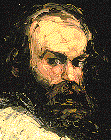| February 6 1996 | BRITAIN |
|
Reproduced from the London Times February 6, 1996 edition with permission. Professor rediscovers rocky landscapes immortalised in galleries across the world |
||
|
||
|
Art detective uncovers Cézanne's inspirations BY
DALYA ALBERGE, ARTS CORRESPONDENT
|
||
|
AN AMERICAN scholar who has spent 30 years following in the footsteps of Cézanne has tracked down the settings for a dozen of his best-known paintings. Pavel Machotka, Professor of Psychology and Art at the University of California, Santa Cruz, has dated and retitled some pictures after finding locations in Provence and on the outskirts of Paris. One of his discoveries, as he travelled through France seeking to match hundreds of photocopied images to places, was that a church which had long been assumed to be in Aix-en-Provence was at Montigny-sur-Loing, in the north. For decades, its ambiguous title was no more than Village Church. Professor Machotka said that it could have been any one of a hundred similar churches in France. Drawing on the locals for guidance, his detective work led him to the building. As a surprising number of landscapes have remained as Cézanne would have known them, the professor was able to find clusters of trees or groups of stone houses set against rocky landscapes, and to take colour photographs of them in the same light that Cézanne painted them. He recalled how he found the Rocks at Estaque, sculpted by nature: "The rock formation had never been seen before. "It was obviously a bay at Marseilles, but nobody had found the formation. The motif is unchanged except for high-tension wires. It was extraordinary. "I was looking at what Cézanne was looking at. After several hours of climbing, I had found the site." The professor's findings are published this week by Yale University Press, coinciding with the exhibition at the Tate Gallery that opens on Thursday. The first Cézanne retrospective since 1936, it is expected to be one of the gallery's most successful shows. First Call, the advance booking agency, has already broken records set by ticket sales for the Monet exhibition and the Tate is preparing for some 300,000 visitors, at a conservative estimate. Cézanne sold barely any of his works and was not given a solo show until he was in his late fifties. Matisse would have thought the show was long overdue: in his eyes, Cézanne was a "god of painting". Among some 90 paintings and 70 watercolours to be seen at the Tate are images that Professor Machotka matched to their locations. Using colour photographs, he was able to explore physical surface, colour relationships and the extent to which Cézanne was painting exactly what his eye was seeing. "Cézanne had a passionate attachment to visual reality," he said. "Unlike other scholars who have viewed Cézanne as an early Cubist, I view him as a painter determined to extract as many visual resonances between the components of the motifs as possible." For example, in taking a colour photograph of La Montagne Saint-Victoire at 9.30am, something that had never been done before, he was able to show the gradual progression of colours from blues to greens which the master subtly incorporated into his painting and the shadows which he transformed into dramatic diagonal, semi-abstract lines. In The Lake at Annecy, one of Cézanne's most famous images, lent by the Courtauld Institute Galleries to the Tate, Professor Machotka's first photograph of the scene shows how similar it is today. A composition that was formerly titled La Saint-Victoire, Environs de Gardanne, he has retitled as Hamlet near Gardanne. He was able to pinpoint its isolated location "by searching for places where a hillside might intersect with the foot of the Sainte-Victoire; by a gradual approximation, I eventually found the hamlet at the end of a narrow road. Cézanne placed his easel at the edge of a field." He added that to judge by the low sun and the brown meadows, Cézanne had painted it late in the year and at 10.30am. The professor said: "A photograph of the site of a well-known painting arouses our curiosity right away: it breaks open the sealed world of the landscape canvas, situates the artist in a place and a moment, and reminds us that an artist searches, gazes, at times disembles, and recombines. It also encourages the hope that we will better understand the artist's purpose and vision." It was impossible to find some sites, particularly those in Paris, which had changed beyond recognition, or the town of St Henri, near Marseilles, whose charming streets had been bulldozed to make way for motorways.
|
||
|
Reproduced from the London
Times February 6, 1996
|
||
